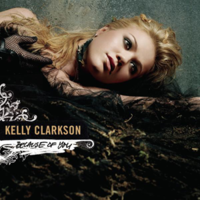Piano Sheets > Kelly Clarkson Sheet Music > Because Of You (ver. 8) Piano Sheet
Because Of You (ver. 8) by Kelly Clarkson - Piano Sheets and Free Sheet Music

About the Song
Other avaliable versions of this music sheet: Version 1 Version 2 Version 7 Version 8
"Because of You" is a song written by pop rock singer Kelly Clarkson, David Hodges and Ben Moody, both formerly of Evanescence, and produced by Hodges and Moody. It is the fourth single (third in Europe) from Clarkson's second album, Breakaway (2004).
In 2007, Clarkson re-recorded the song as a duet with country music artist Reba McEntire for Reba's album Reba: Duets (2007). The duet version was released in Summer of 2007, reaching a peak of #2 on the Billboard Hot Country Songs charts, becoming Clarkson's first official entry on that chart.
In the UK, "Because of You" was the second most played song in the five years to 2008, counting television, radio, website and live venue plays.
On January 31, 2008 the single was certified platinum by RIAA and has sold over 1,500,000 copies in all formats in the US. Kelly Brianne Clarkson (born April 24; 1982) is an American pop rock singer; songwriter;.
Download this sheet!
About the Artist

Random article
How to locate free sheet music easily If you want to learn how to play piano then having access to free sheet music can be an inexpensive and great way to learn! There are plenty of websites online, which offer you high quality sheet music free. Here are some ways you can locate these sources for your benefit.
The concept of free
If a site provides sheet music, which you can download and print without any infringement of copyright or violations then this is free sheet music. Some websites may have a prerequisite of attaining membership via subscriptions to newsletters or registering with an account. In order to arrive at sites providing no obligation free sheet music, it may take a bit of effort and patience but the results are worth it!
(More...)
